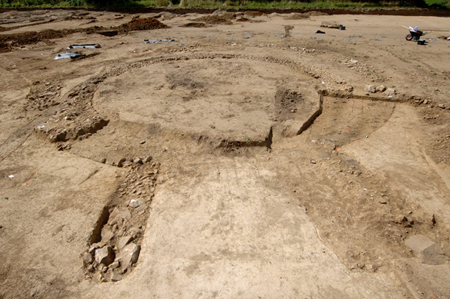 Archaeologists have discovered a large Gallo-Roman religious complex located only a few kilometres from the ancient city of Le Mans. The ancient sanctuary is thought to have been an important pilgrimage area, visited by thousands to honour the gods.
Archaeologists have discovered a large Gallo-Roman religious complex located only a few kilometres from the ancient city of Le Mans. The ancient sanctuary is thought to have been an important pilgrimage area, visited by thousands to honour the gods.
The religious complex unearthed in Neuville-sur-Sarthe about 5km north of Le Mans, France is excavated by archaeologists from the French National Institute of Archaeological Research (INRAP) and dated to the 1st to 3rd century AD. Traces of the complex were first revealed on aerial photographs taken in 2003, when an long period of drought scorched much of the vegetation on the site, yet nobody anticipated its sheer size the complex spans more than 4 acres.
The ancient sanctuary, clearly divided in three areas, contains several Gallo-Roman temples (fana) in various shapes quadrangular, polygonal and circular and sizes, linked by roads and galleries.
In the west, the main temple and five shrines are located. The temple (or fanum) is a 15m square structure characterized by a sanctuary, a central altar dedicated to the gods, surrounded by a gallery where the faithful would worship. The few architectural fragments discovered, suggest that it was a Corinthian style building with plaster wall paintings. The structures are surrounded by a 60m by 40m quadrangular brick wall enclosure (or temenos).
VIDEO: The Neuville-sur-Sarthe Gallo-Roman Sanctuary Dig
The large number and diversity of theartefacts unearthed within the sacred enclosure all dated to the 1st century AD testify to the importance of the sanctuary.
Worshippers left behind plenty of coin, bronze and silver fibulae (cloak fasteners), knives and a dagger likely a soldier’s offering. The most preciousfind is a golden ring,decorated with green quartz bearing the effigy of a deity (visible in the video on the left).
South of the main temple, the excavations revealed a curiously designed circular temple, 12m in diameter, flanked by a smaller square temple annex. Both are constructedaround 200AD. Although compared to the main sanctum, the round temple is only scarcely decorated, its circular structure is exceptional. So far, only three or four similar examples have been excavated in France. Another particularity is that the temple’s entrance is oriented to the north rather than to the more common east. The discovery of numerous postholes suggests a pergola over fifty metres long covered the entranceway.
North, a 8m by 8m E-shaped structured aligned to the main temple’s entrance was revealed. It is believed this building was used for welcoming pilgrims and for selling them various religious objects, which the devout could then offer to the god(s).
No dedication to a specific deity have been unearthed at the Gallo-Roman sanctuary, yet the presence of eye-shaped votive offerings suggests the sanctuary was part of a cult devoted to a god of healing.
The archaeologists have until September to complete the excavation. The finds will likelygo on display at the Carr Plantagent, the archaeology and history museum in Le Mans.